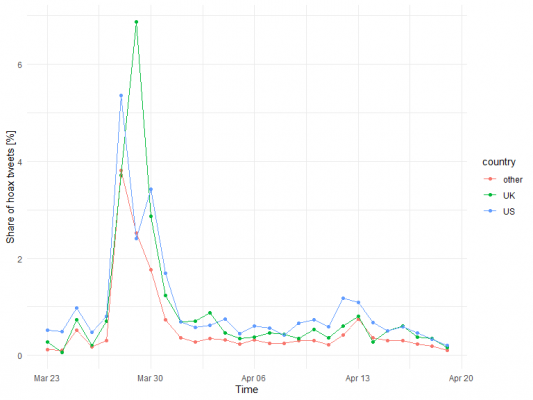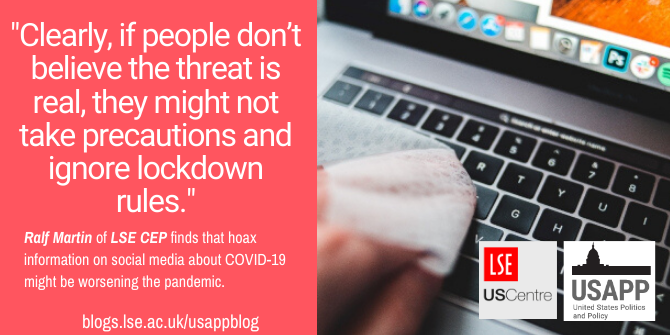 Information claiming that the COVID-19 is a hoax has unfolded on social media at the same time as the virus has spread across the world. Ralf Martin has analysed nearly 12 million tweets for spikes in COVID-19 hoax related content. He finds that those posting coronavirus related hoax content are more likely to mention Donald Trump, and that many areas where hoaxism is prevalent, like New York, also have higher infection rates.
Information claiming that the COVID-19 is a hoax has unfolded on social media at the same time as the virus has spread across the world. Ralf Martin has analysed nearly 12 million tweets for spikes in COVID-19 hoax related content. He finds that those posting coronavirus related hoax content are more likely to mention Donald Trump, and that many areas where hoaxism is prevalent, like New York, also have higher infection rates.
The coronavirus pandemic has changed everything overnight. Unfortunately, as the genetic sequence of the virus started to make its deadly journey through bodies around the world, in parallel another sequence has emerged in the minds of some: the idea that COVID-19 pandemic is not real and is in fact a hoax. Indeed, concern is growing that the two infections exist in a symbiotic relationship with one helping to advance the survival and spread of the other as the growing belief that the pandemic is hoax potentially preventing people from following guidelines to limit its spread.
To monitor and study this phenomenon we (a team of Imperial College and LSE researchers) have been sampling tweets mentioning the terms “corona” and/or “covid”. Since 23 March we have collected just under 12 million tweets. We measure hoaxism by looking for tweets with the hashtag #hoax (or #coronahoax, #covidhoax). There was a massive spike in hoaxism around the weekend of 28 March with hoax tweet rates of over 4 percent on some days. With the onset of April hoaxism declined to rates around 0.5 percent. Overall, we find a cumulate hoaxism share of 0.5 percent for the UK and 0.7 percent for the US.
Figure 1 – Hoaxism over time

What are the drivers of hoaxism? One hypothesis is that hoaxism was driven by President Donald Trump who had a vested interest in downplaying the crisis because of worries that the economic fallout could dampen his re-election chances. We can examine this by looking at word clouds of all tweets by prolific hoaxist tweeters (Figure 2):
Figure 2 – Word cloud of hoaxist’s tweets

We find that Trump is a popular term among hoaxists. Indeed, we find that his probability of being mentioned by hoaxists is significantly larger than among non hoaxist covid tweeters (7.9 percent as opposed to 3 percent).

Photo by Erik Mclean on Unsplash
Of course, the big question is whether hoaxism matters for actual covid outcomes? Clearly, if people don’t believe the threat is real, they might not take precautions and ignore lockdown rules. But does this matter in practice? To start answering this, we correlated infection rates (COVID-19 cases per 1000 residents) with hoaxism infection rates at the level of US states (see Figure 3). It is very striking that New York does not only have record levels of covid infections but also record levels of hoaxism. But of course, there are other states (notably North Dakota, Alaska and Alabama) with high hoaxism levels but rather low infection rates.
Figure 3 – Hoaxism vs Covid Infections

Various people have suggested that population density is an important factor in explaining covid infection rates. So perhaps, what matters is the interaction between the two. This is particularly plausible when comparing New York and New Jersey, which has higher density but lower covid and lower hoaxism rates than New York. What’s more, while we have to be cautious in interpreting correlation as causation, a causal interpretation of our current numbers would imply substantial impacts of hoaxism: For the US it could suggest that the number of COVID-19cases would have been about 20 percent lower without hoaxism. Clearly, this warrants further investigation. One issue with the results for New York could be that we lump metropolitian areas of New York City together with rather rural areas of New York state. We will therefore continue to monitor and analyse hoaxists tweets. Updates will be here.
Figure 4 – Population density vs Covid Infections

Please read our comments policy before commenting.
Note: This article gives the views of the author, and not the position of USAPP– American Politics and Policy, nor of the London School of Economics.
Shortened URL for this post: https://bit.ly/3507ASm
About the author
 Ralf Martin – LSE Centre for Economic Performance and Imperial College Business School
Ralf Martin – LSE Centre for Economic Performance and Imperial College Business School
Ralf Martin is a Research Fellow in Productivity and Innovation at the Centre for Economic Performance at LSE, and an Associate Professor of Economics at Imperial College Business School.




I’m not as academic as those who seem annoyed when I question the trustworthiness of data from our government’s health organizations. I just want to know simple answers without partisanship debate.
My interest is fueled by conversations with relatives in healthcare, friends in health care, 3 doctors I rely on for health care along with everyone who will tolerate me asking what they think. I was a business owner for 32 years and this government mandated shutdown breaks my heart.
I’m 65 and consider myself healthy but remember having horrible flu symptoms. I don’t want to go through that again, but is COV19 worse? I know it’s more contagious, but is it worse?
I ask everyone who will listen to me. Democrats usually say, “without question, and if you don’t think so, you’re stupid”. Well, kind of. Republicans will usually say, “it’s all a hoax”. Or something like that. I try not to represent either side of the lying liars club, so I can get honest answers.
First question, “what gives you enough confidence in our government’s statistics to agree this a “pandemic” of proportion to shut down our entire economy? Please be kind in responding.I would appreciate an answer without “government statistics”, just you’re educated opinion.
Respectfully ~ Rick